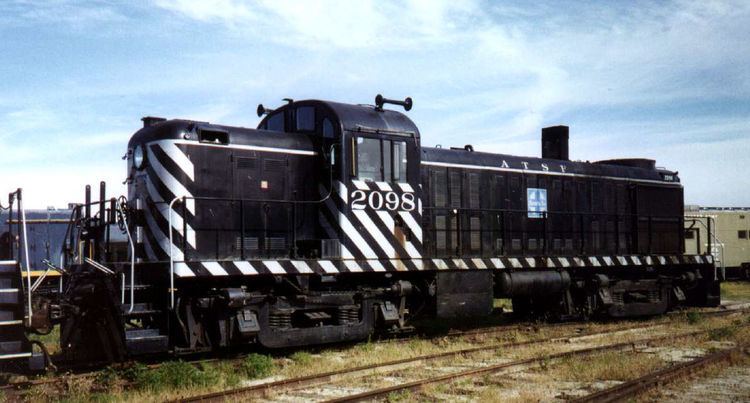Power type Diesel-electric Total produced 378 | Model RS-2 AAR wheel arr. B-B | |
 | ||
Builder American Locomotive CompanyMontreal Locomotive Works Build date October 1946 (1946-10) – February 1950 (1950-02) | ||
The ALCO RS-2 is a 1,500 horsepower (1,100 kW), B-B road switcher diesel-electric locomotive. It was manufactured by American Locomotive Company (ALCO) from October 1946 to May 1950, and 378 were produced — 369 by the American Locomotive Company, and 9 by Montreal Locomotive Works in Canada. Eight of the ALCO RS-2s were exported to Canada. The RS-2 has a single, 12 cylinder, model 244 engine, developing 1,500 horsepower (1,100 kW). Thirty-one locomotives built by Alco between February and May 1950 with the 12 cylinder 244C 1,600 horsepower (1,200 kW) engine.
Contents
ALCO built the RS-2 to compete with EMD, Fairbanks-Morse, and Baldwin Locomotive Works. In 1947, Fairbanks-Morse introduced the 1,500 hp (1.1 MW) H-15-44. Also in that year, Baldwin introduced the 1,500 hp (1.1 MW) DRS-4-4-1500. In the case of ALCO, Fairbanks-Morse, and Baldwin, each company increased the power of an existing locomotive line from 1,500 to 1,600 hp (1.1 to 1.2 MW)), and added more improvements to create new locomotive lines.
EMD, however, kept its competing GP7 at 1,500 hp (1.1 MW) In 1954, EMD introduced the GP9. It was rated at 1,750 hp (1.30 MW).
EMD produced 2,734 GP-7s. ALCO produced 378 RS-2s, and 1,370 RS-3s. Fairbanks-Morse produced 30 H-15-44s, and 296 H-16-44s. Baldwin produced 32 DRS-4-4-1500s, and 127 AS-16s.
Design and development
The RS2 was a further development of the road switcher concept. It had more horsepower than the RS1, and was better suited for heavy road service. Externally, the RS2 bodywork was more rounded, while mechanically the new 244 engine was introduced. A turbocharged four stroke V12 with a 9 in × 10 1⁄2 in (229 mm × 267 mm) bore and stroke developing 1,500 (later 1,600) hp at 1,000 rpm, it had a smaller cylinder, higher cylinder speed design than the 539 used in the RS1. Production of the RS-2 was delayed several months while Alco worked out the new four pipe divided low rise manifold for the GE constant pressure RD-1 turbocharger. The 244 engine was not a reliable design, however, and was replaced in less than ten years by the Alco 251 engine.
Survivors
Very few RS-2s survive today. Three former Kennecott Copper locomotives are preserved, including Kennecott Copper 908 (former number 104) at the Western Pacific Railroad Museum at Portola, California. KCC 908 once served the mines out of Ely, Nevada along the Nevada Northern Railway. Nevada Northern 105 is at Ely, Nevada, it was formerly the Kennecott Copper 105. Kennecott Copper 103 is at the San Diego Railroad Museum in Campo, California. It is painted as Santa Fe 2098. Another RS-2 is in active service on the Texas State Railroad (rebuilt as an RS-2-CAT). It is the former Union Railroad 608. The first production RS-2, originally sold to the Detroit & Mackinac RR as their number 466, was fully operable in freight service on the Michigan Southern Railroad (1989) until a few years ago. As of September 2005, the 466 was stored out of service near the Michigan Southern's office in White Pigeon, Michigan, it was finally scrapped in December 2011. The former Detroit & Mackinac 469 was sold to Waymore Power and may be restored. The former Elgin Joliet and Eastern 801 is preserved in Jala, Mexico as a Las Encinas SA de CV 801. And MLW built Roberval and Saguenay 20 is at the Canadian Railway Museum.
